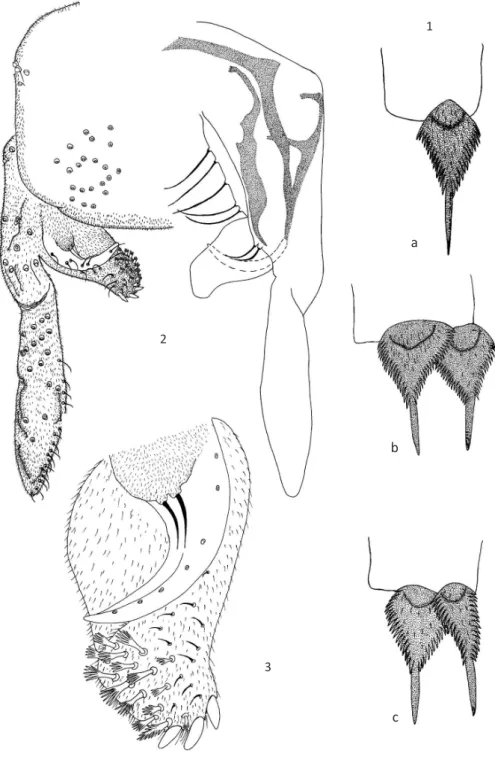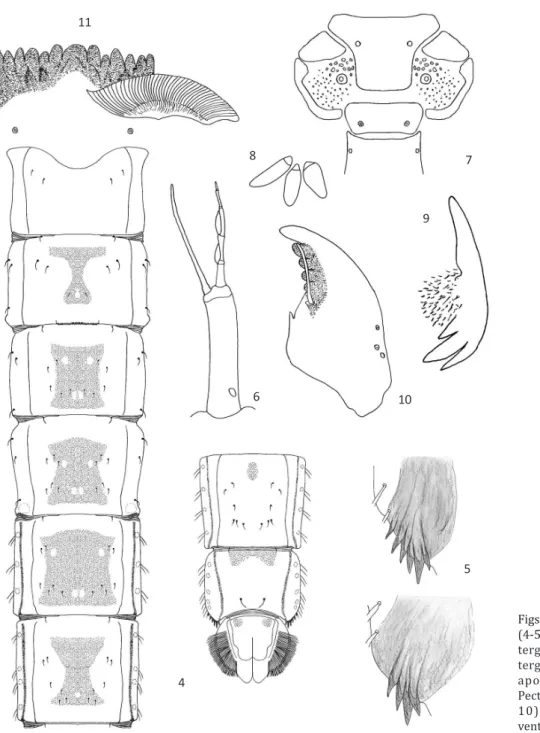journal homepage: www.scielo.br/ne ISSN: 1519-566X
SyStEmatIcS, morphology aNd phySIology
Riethia manauara
n. sp., an amazonian chironomid (diptera: chironomidae)
from Brazil
CSO Neubern, S Trivinho-Strixino, FL Silva
Lab de Entomologia Aquática, Depto de Hidrobiologia, Univ Federal de São Carlos, São Carlos, SP, Brasil
Keywords
Neotropical, aquatic midge fly, immature stage
Correspondence
Fabio L da Silva, Lab de Entomologia Aquática, Depto de Hidrobiologia, Univ Federal de São Carlos, CP 676, São Carlos, SP, Brasil; fabelha@ hotmail.com
Edited by Roberto A Zucchi – ESALQ/USP
Received 05 April 2011 and accepted 10 May 2011
Abstract
One new species of Riethia Kieffer, Riethia manauara n. sp., is
described and figured as male, pupa and larva. The generic diagnosis for pupae and larvae are emended. The specimens were collected from water systems in the Amazon Rainforest in northern Brazil.
Introduction
The genus Riethia was erected by Kieffer in 1917 based on specimens from Australia. It includes non-biting midges whose larvae inhabit the bottom of lotic and lentic systems associated with sandy and fine particulate organic matter. Prior to the present study, Riethia comprised six species described, all of which, except Riethia truncatocaudata (Edwards) were known only from the Australasian region (Trivinho-Strixino et al 2009).
Riethia species were described by a few authors based on adult males (Kieffer 1917, Edwards 1931, Freeman 1961). A tentative key to larvae and pupal exuviae which included many undescribed species from Australia was provided by Cranston (2000). In the Neotropical region, Ospina-Torres (1992) and Wiedenbrug (2000) recognized some pupal exuviae of Riethia in Brazil. Trivinho-Strixino et al (2009) redescribed the male of R. truncatocaudata,
including descriptions of the previously unknown immatures and female, and considered it to be a senior synonym of Riethia melanoides (Edwards).
Although these publications have elucidated the status
of some Riethia species, a comprehensive revision of the genus remains unavailable. In the present study, one new
species of Riethia is described in all stages and generic diagnoses to the immature stages (Trivinho-Strixino et al 2009) are emended.
Material and Methods
The type material is deposited in the “Coleção de Referência do Laboratório de Entomologia Aquática (LEA), Universidade Federal de São Carlos (UFSCar)”, São Carlos, Brazil and in the “Coleção de Invertebrados do Instituto Nacional de Pesquisas da Amazônia (INPA)”, Manaus, Brazil.
Riethia Kieffer
Riethia Kieffer, 1917: 203.
Type species. Riethia stictoptera Kieffer
Emended diagnosis. Based on the Amazonian specimens, the generic description of Riethia to pupa and larvae (Trivinho-Strixino et al 2009) must be emended (in bold) as follows: pupa with transverse band of dorsal spines on conjunctives III/IV and IV/V present or absent. Pedes
spurii B present or absent. Larva may have antenna with
five or six segments. Lauterborn organs on apex of 2nd or
2nd and 3rd segments.
Riethia manauara n. sp.
Type material. Holotype male with larval and pupal exuviae, BRAZIL: state of Amazonas, Manaus, Lago Catalão, INPA - Base Flutuante de Pesquisa, 10/vii/2008, CSN Oliveira & LM Fusari (LEA). Paratypes: one male with pupal exuviae, same data as holotype (INPA); two larvae, state of Amazonas, Manaus, 11/ix/2003, S Couceiro (LEA); two larvae as previous except for 1993 (LEA). Etymology. Named after the district of Manaus in the state of Amazonas, where specimens were collected.
Diagnostic characters.Riethia manauara differs from other
species of Riethia (described and not formally described) by the combination of the following characters. Male:
hypopygium with superior volsella hooklike, basally pubescent; distal margin with about six long simple setae. Median volsella short, with two simple setae. Inferior volsella with flattened scales; numerous apically pectinate and three distally non-pectinate. Pupa: cephalothorax
strongly granulose. Hook row extending nearly on 1/3 the width of tergite II. Conjunctives III/IV and IV/V bare. Longitudinal creases extending the full length of tergites II-VI. Larva: antenna with six segments. Lauterborn
organs on apex of 2nd and 3rd segments.
Male (n = 2 unless otherwise stated)
Size. Total length [5.47] 5.25-5.47 mm. Wing length [2.27] (1) mm. Total length/wing length [2.41] (1).
Color. Head, antenna and maxillary palp pale brown. Thorax brown with scutellum pale brown. Wings unmarked. Legs yellow and spurs brown. Abdomen pale brown with dark brown marks. Hypopygium brown. Head. Antenna with 13 flagellomeres, AR 2.32 (1),
flagellum 1125 (1) μm long. Temporal setae 15-[16], uniserial. Tentorium 217-[231] μm long. Stipesn75-[85] μm long. Clypeus with [29]-34 setae. Palpomere lengths 1-5 (in μm): [51]; [62]-70; 123-[137]; 137-[154]; 192 (1).
Thorax.Antepronotal lobes reduced, separated medially,
each lobe with [9]-11 lateral setae. Acrostichals 10 (1), uniserial; dorsocentrals uniserial 11-[13]; prealars 4 (1); scutellars biserial 14-[15].
Wing.Width [0.56] (1) mm. Brachiolum with [2] setae
(1). Squama with [13] (1) setae.
Legs (Fig 1).Mid and hind leg spurs paired, subequal in length. Tibial spur lengths (µm): fore 72-[106] (Fig 1a); mid [110]-113 (Fig 1b), hind [97]-106 (Fig 1c).
Hypopygium (Figs 2-3). Tergite IX truncate, without anal point. Laterosternite IX with [3]-4 setae. Transverse sternapodeme [143]-154 µm long. Phallapodeme [69]-95 µm long. Gonocoxite 192 (1) µm long. Superior volsella hooklike, basally pubescent, with six simple setae. Median volsella short, broad, bearing two simple setae. Inferior volsella [92]-106 µm long, with nine simple setae and 18 flattened scales: 15 apically pectinate and three distal ones broadened and non-pectinate (Figs 2-3). Gonostylus 260-[277] µm long. HR 0.73 (1).
Pupa (n = 2 unless otherwise stated)
Size.Abdomen 5.47-[5.55] mm long.
Color.Exuviae brown.
Cephalothorax. Antennal sheath usually without pearl row. Frontal setae and cephalic tubercles absent. Frontal warts not discernible. Wing sheath [1.69]-1.75 mm long. Thorax strongly granulose; antepronotals [2], longest setae 132 (1) μm long; precorneals [3], Pc2 [108] µm;
dorsocentrals [4]. Distance Dc1-Dc2 [38]-38 µm; Dc2
-Dc3 281-[288] µm; Dc3-Dc4 [19]-38 µm. Thoracic horn elongate, about [550] (1) µm, with lateral spinules along whole length.
Abdomen (Fig 4). Tergite I bare; II-VI with anterior transverse band of strong shagreen connecting with longitudinal creases extending the full length of segments. Hooklets row, interrupted medially, extending nearly on 1/3 the width of tergite II. Pedes spurii B present on segment II. Pedes spurii A present in segment IV. Tergite VIII with posterolateral comb, usually with 4-[6] marginal teeth (Fig 5). Segments I-V with 0, 3, 3, 3, 3 L setae, respectively; segments VI-VII with four taeniae; segment VIII with five taeniae. Anal lobe [500] µm long, with complete fringe of about 140 taeniae in multiple rows; with anterior shagreen. Genital sac [331]-350 µm long.
4th instar larva (n = 5 unless otherwise stated)
dark brown. Abdomen and claws yellow.
Head 138-[188] µm long, 438-[569] (3) µm wide. Antenna (Fig 6). [180] 154-202 (3) μm, with six segments, basal segment [85]-105 (4) µm long, AR [0.88]-1.32. Lauterborn organs 15-20 (3) µm long, on apex of 2nd
and 3rd segments. Blade [83] 81-127 surpassing 6th
segment.
Labrum (Figs 7-9). Dorsal sclerites of head as in Fig 7. SI plumose, arising from common base; SII narrow. Pecten epipharyngis composed of 3 plates (Fig 8). Seta premandibularis simple; premandible [67] µm long, trifid
with two large apical teeth and one smaller proximal teeth; brush present (Fig 9).
Mandible (Fig 10). Length [139] 129-159 µm, with one strong apical tooth and four small inner teeth. Seta subdentalis [41] 40-51 µm long, extending to base of apical tooth, inserted on mid-surface of mola, but lying along the inner surface. Outer margin smooth; mola with [2]-3 spines; Pecten mandibularis absent and dorsal tooth absent.
Mentum (Fig 11). Width [117]-154 µm, with rounded median tooth and five pairs of lateral teeth, 2nd lateral
Figs 1-3 Riethia manauara n. sp. male. 1) Tibial spurs: a. fore, b. mid, c. hind; 2) Hypopygium, left: dorsal aspect, right: ventral aspect; 3) Superior, median and inferior volsella.
1
a
b
c
2
tooth smaller than 1st and 3rd. Ventromental plates
[123]-189 µm wide, nearly touching medially.
Abdomen. Anterior and posterior parapod with simple claws. Lateral tubules absent. Procercus short, with two setae lateral and with about eight setae. Anal tubules slender, 268 (1) µm long.
Remarks
The male of R. manauara resembles R. truncatocaudata (Edwards 1931) and one Australian undescribed species (‘kakadu type’) (Cranston 2000) by the morphology of the superior volsella and the possession of the flattened,
apically pectinate scales on the inferior volsella, but the three broadened and non-pectinate scales at the apex of the volsella in R. manauara separate these species. The pupa of R. manauara can be distinguished easily from other Riethia species including formally undescribed species (Ospina-Torres 1992, Cranston 2000, Wiedenbrug 2000) by conjunctives the tergal III/IV and IV/V lacking any transverse band of dorsal spines. The larva of R.
manauara seems to be related to R. truncatocaudata,
but differs in antenna morphology, with six segments and Lauterborn organs alternate on the apices of the 2nd
and 3rd segments.
Figs 4-11 Riethia manauara n. sp. pupa (4-5) and larva (6-11). 4) Abdominal tergites; 5) Posterolateral comb on tergite VIII; 6) Antenna; 7) Frontal apotome and labral sclerites; 8) Pecten epipharyngis; 9) Premandible; 10) Mandible; 11) Mentum and ventromental plate.
11
9 8
6
4
5 10
Acknowledgments
The authors are indebted to Dr. Peter S. Cranston for valuable suggestions on the manuscript. Thanks are also to Dr. Sheyla Couceiro for providing important material and Dr. Lívia Fusari for her assistance in the fieldwork. Finally, we would like to thank the Conselho Nacional de Desenvolvimento Científico e Tecnológico (CNPq) and the Programa Nacional de Cooperação Acadêmica (Procad - UFPR/INPA) for financial support.
References
Cranston PS (2000) Electronic guide to the Chironomidae of Australia. http://entomology.ucdavis.edu/chiropage/index. html. Accessed Feb 2011.
Edwards FW (1931) Chironomidae, Diptera of Patagonia and South Chile. Trust Br Mus Nat His 2: 233-331.
Epler JH (1988) Biosystematics of the genus Dicrotendipes Kieffer, 1913 (Diptera: Chironomidae: Chironominae) of the world. Mem Am Entomol Soc 36: 1-214.
Freeman P (1961) The Chironomidae (Diptera) of Australia, Aust J Zool 9: 611-737.
Kieffer JJ (1917) Chironomides d’Amérique conserveés au Museé National Hongrois de Budapest. Ann Hist Nat Mus Natl Hung 15: 292-364.
Langton PH (1994) If not ‘‘filaments’’ then what? Chironomus 6: 9-9.
Ospina-Torres R (1992) Die Chironomidenfauna zentral-amazonischer Waldbäche. Ph.D. thesis, Munich, Ludwig-Maximilians-Universität, vol I, 377p. / vol II, 221p.
Sæther OA (1980) Glossary of chironomid morphology terminology (Diptera: Chironomidae). Entomol Scand Suppl 14: 1-51. Trivinho-Strixino S, Roque FO, Cranston PS (2009) Redescription
of Riethia truncatocaudata (Edwards, 1931) (Diptera: Chironomidae), with description of female, pupa and larva and generic diagnosis for Riethia. Aquat Insects 31: 247-259. Wiedenbrug S (2000) Studie zur Chironomidenfauna aus

